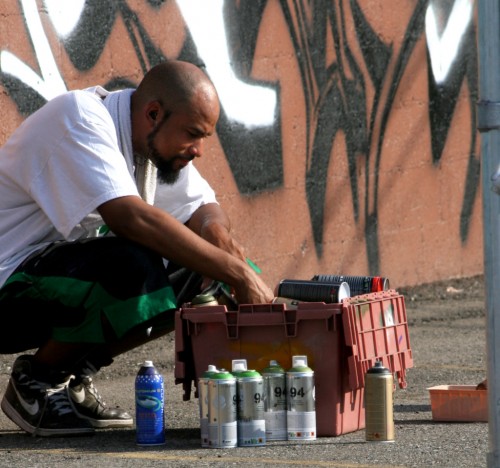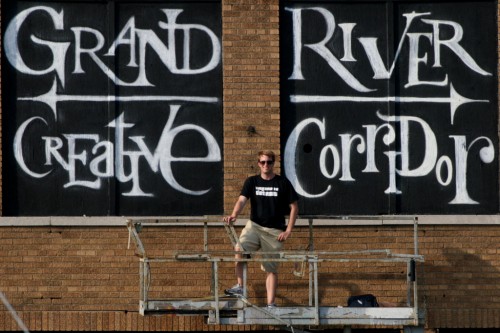
555 Nonprofit Gallery and Studios at their new home, which is a renovated police station. This is a great example of the unique opportunities in Detroit.
During Art Basel in 2010, Creative Time and Art Basel Miami Beach teamed up for Oceanfront Nights, which showcased the “big four” art cities: Berlin, Glasgow, Mexico City, and—to the surprise of many—Detroit. Similarly in 2010, the poet and rocker Patti Smith surprised many with her advice that young artists should move to Detroit, because “New York has closed itself off to the young….”
It has been two years since these two events; should artists move to Detroit? I talked to artists and gallery owners in the city to get their thoughts about Detroit and its artistic present and future. I also spoke to established and rising art stars in New York—an undeniable art capital—to compare and contrast that city’s opportunities with Detroit’s opportunities.
There are a lot of similarities and a lot of differences between the areas. New York cannot compare with Detroit in terms of cost of living, and Detroit cannot compare with New York in terms of established networks (and pure size of everything). What Detroit does have right now is a steady stream of media interest in its art scene. In fact, PBS NewsHour just ran a segment on Detroit’s art scene this past Wednesday (July 25, 2012) titled: Detroit Art City. Detroit’s art narrative has captured the imagination of many.
I initially talked to Monica Bowman, an arts professional who moved from the Detroit area to New York, and then back to the Detroit area in 2008 to start The Butcher’s Daughter Gallery in Ferndale, which is part of Detroit’s metro area. Her gallery received instant attention. She explained that the gallery has doubled its business every year, and she has been able to create a bridge between Detroit and the national art market. Part of that bridge is participating in the PULSE brand of fairs, and working with rising art stars locally and nationally.
For example, her gallery represents New York’s rising art star Michael Anderson. Michael is a respected collage artist who uses posters ripped down from the streets from major cities around the world (including New York and Detroit) to create large-scale collages that are seven or more layers thick. The end results are mesmerizing, layered stories that reflect an artist digesting the city stories of today to tell his own unique story.
I asked Michael how he teamed up with The Butcher’s Daughter. I was particularly interested in Michael’s opinion because he is a New York-based artist who exhibited with a Detroit-based gallery at New York’s PULSE Contemporary Art Fair this past year. He explained that he met Monica while she was still in New York, they hit it off, he visited Detroit, and he fell in love with the city. He went on to note that “The Detroit art scene is incredibly interesting and unusually experimental. I really enjoyed meeting the artists there who are able to get tremendous spaces and have a great DIY sensibility. The artists are really experimenting on the boundaries of art and take interesting chances with what they make.”
Is anything possible in Detroit? Michael is excited about the idea of using Detroit’s large spaces to create an exhibit of Detroit artists similar to a Group-in-Fusion exhibition he did last year in Athens, Greece. There, he rented a five story building in the center of the city, put his studio on the top floor (with a view of the Acropolis), and curated an exhibition in the rest of the space for forty-three young Athenian artists. During that event he had various bands playing–Detroit’s music scene has never slowed down.
When I asked Monica about the biggest detriment and biggest benefit of opening a space here, she explained that, “the biggest detriment is one of the largest benefits. Detroit is like the Wild West. Anything can happen, anything is possible, and the only thing between you and your dreams is the frontier.”
I’ve actually heard this answer a lot from people that put their professional footprint here: Detroit has claimed the romantic storyline where “anything goes.” The community as a whole is building upon an ever-growing body of ideas–where good ideas get the green light quickly (or people do not even wait for a green light and just do things and ask for permission later).
While the notion of a grand frontier is enticing, artists still need to make a living. One of my concerns, and a concern for many artists in the area, is finding collectors. Topher Crowder, one of Detroit’s established artists, jokingly observed that “There are plenty of collectors in Detroit. They collect chrome rims from 20 year old Buicks … for cabins “Up North.” But not art. Metro Detroit as a community has little regard for exchanging cash for art.” Topher has been exhausted by galleries in Detroit and the Detroit metro area that focus more on a duty to give back to the community than giving back to artists (in terms of actually promoting and selling the artist’s work). He credits this to some galleries’ lack of business acumen. He me this story: he and his wife are collectors; they went to a local gallery and wanted to buy a piece that was around a thousand dollars, but the gallery did not accept credit cards. The gallery lost the sale. For his own work, Topher is adept at using the Internet, in particular Ebay, to find collectors (he also has a cargo van and delivers his work coast to coast).
There are some galleries that are able to tap into Detroit’s collector base. There are actually a number of Detroit/Metro Detroit collectors that make the list of ArtNews’ 200 Top Collectors. And, as mentioned in my previous post, Detroit does have an educated base of art patrons—the key is building on the latest press to show these collectors the talent of local artists, because a lot of collectors still focus on artists living outside Detroit. This positive press can also, hopefully, lead to local artists being able to use the Internet to find collectors from around the world and to create enough buzz so that collectors in their own backyard take notice.
For Detroit to truly be a destination point for the arts like Soho, Chelsea, and London are, it needs to capitalize on and sustain its recent buzz. I have spoken with a lot of artists and art professionals outside of Michigan about Detroit, and almost all of them have said that they hear great things about Detroit, so Detroit just needs to keep doing what it is doing. There were a few that mentioned that their only image of Detroit are of the abandoned buildings and factories that periodically pop up.
But could the voices that speak positively about Detroit slowly grow silent? For many artists in this area, including Topher, New York is still the artist’s dream location.
I’ve noticed that the Bushwick area of Brooklyn, NY, has a similar DIY attitude. This past spring a few artists from that area showed at Art Effect Gallery in Detroit’s Eastern Market for TheDetroiter.com’s First Annual Invitational Show and Panel Discussion. The show was titled Beauty Debate, and it was successful in creating a bridge between the two communities. So in my search for a better understanding of where Detroit is and where it can go, I often try to compare Detroit to what is going on in Bushwick.
Bushwick has the DIY gene and it is still close to established collectors. Man Bartlett (a New Media artist whose work has been featured in Art in America, ARTnews, and LA Weekly) noted that because his studio is located in Bushwick, it is still “ok” for collectors in the City to visit, but if he was farther away in a less established neighborhood, it would be harder for him to get collectors, friends, curators, etc. to come by.
From what I can tell, the prices for studio spaces in Bushwick and Detroit vary greatly. I found the best deal for a studio space in Bushwick is about $1.50 per square foot, and the best deal for a studio space in Detroit is about $1 per square foot. It also seems that Bushwick has similar openings for an individual to start a space for artists. For example, shortly after graduating from RISD, Ashley Zelinskie started a large studio space and gallery in Bushwick called The Active Space (with thirty-seven artists studios and 1,500 square feet of gallery space). Even though it is a new space,The Active Space’s Bushwick Open Studios exhibition with Deborah Brown was featured in The New York Times three weeks in a row this past month. Her space has also been featured is local and national publications and blogs such as Bushwick Daily, Brooklyn Magazine, L Magazine, and Art Fag City, and this coverage has resulted in a decent amount of foot traffic and attention from collectors.
If Detroit and Bushwick are comparable, but Bushwick is closer to collectors—why would artists move to Detroit rather than Bushwick?
The main difference, and the main trouble with this comparison, is that Bushwick is a neighborhood of a major city while Detroit is a major city (despite its well publicized ups and downs, it still has about seven times the population of this particular neighborhood, and it has skyscrapers and museums). So, from what I can tell, the DIY attitude can go farther in Detroit in terms of scale.
For example, on a shoestring and without ties to the state, Tate Osten opened the Kunsthalle Detroit Museum of Multimedia and Light-based Art in a vacant bank in Detroit, and she is busy planning the TransLUMINALE Biennial, which will take place this fall. Similarly, Brian Barr (an artist and professor at Detroit’s Center for Creative Studies) is in the final stages of opening PASSENGER, which will be a creative center with an exhibition/project space, studios, affordable apartments, and residency programs which will be housed in a skyscraper in Downtown Detroit.
My favorite example right now is the Grand River Creative Corridor. This past week, a Detroit art patron named Derek Weaver teamed up with Detroit graffiti artist Sintex to make some positive changes to a whole block of businesses. Several established artists donated their labor and created beautiful murals throughout Grand River Avenue (a major avenue in Detroit). The project was completed on a shoestring, received and continues to receive positive press, and it was all done on a huge scale that made a permanent impact on a community.
Establishing museums, taking over buildings, and painting major city blocks is a great way for artists and art enthusiasts to create positive buzz. If the buzz is loud enough, will the collectors come?






Pingback: Detroit’s Artistic Opportunities | ArtSibs
Pingback: 100 Abandoned Houses | Lachlan SEA